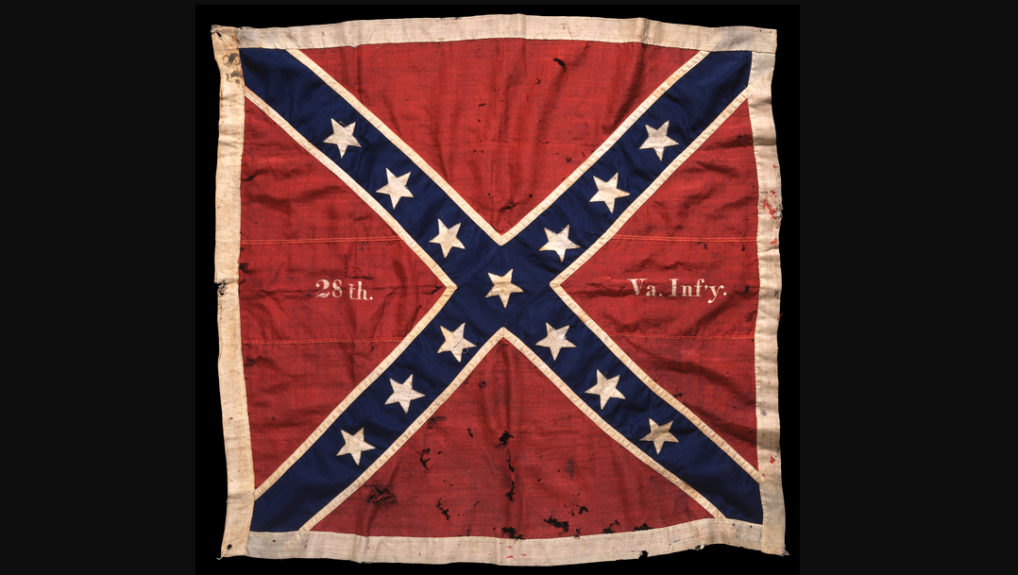The Last Confederate POW
The American Civil War raged for more than four years, from 1861 into 1865. For the first two years, the Confederacy — the rebel states — were seeing many gains on the battlefield. The tide turned in July of 1863, though. Led by General Robert E. Lee, the Confederate’s Army of Northern Virginia pushed into the northern, Union state of Pennsylvania. The Confederacy planned to force the turmoil into the North; the ills of war, they hoped, would cause the leaders of that state to capitulate to the South’s demands. The plan was unsuccessful. Over three days, from July 1st to the 3rd, the two sides met on the battlefield in Gettysburg. Ultimately, approximately 50,000 soldiers were wounded or killed over those three days and Lee’s army was unable to break through the Union line. Lee’s army, defeated, retreated back into Virginia — and never really recovered.
And there’s something else they never recovered — this:

That’s a Confederate battle flag, used by the 28th Virginian Infantry during the Battle of Gettysburg. As the Pioneer Press (a Minnesotan publication) explains, the flag was “captured by the First Minnesota Pvt. Marshall Sherman” during the battle. And it’s not only a spoil of war, but it’s a reminder of loss; per the Pioneer Press, “many of the First Minnesota Regiment, a volunteer force, died in the Union battle against the South, and Sherman was awarded the Medal of Honor for his role.” The captured flag is a symbol of triumph over the rebellion and yearn for slavery for which it stands.
To Virginia, though, it’s also a symbol of their war dead. And after the war, they wanted it back. That shouldn’t have been a big ask — as the Roanoke Times (a Virginia publication) notes, “in 1905, in a mood of national reconciliation, Congress ordered the War Department to return captured Confederate flags to their home states.” The flag above, though, wasn’t returned, and its existence effectively was lost to history for nearly half a century. But in 1961, that changed. Per the Roanoke Times, “that year, Minnesota — with much fanfare — returned one of its captured flags to Georgia and noted it still had the Virginia flag.” And they weren’t about to give it up.
While Virginia sees the flag as rightfully theirs, Minnesota views the flag as a symbol of their battlefield losses. Over the years, that hasn’t changed. Virginia has requested the flag be returned many times over the course of the past six decades, and each time, Minnesota has declined. Even the courts have gotten briefly involved. In 2000, according to the Atlantic, “Chris Caveness, a Roanoke resident spearheaded a federal lawsuit to get the flag back in Virginia,” citing the 1905 order, but “the litigation did not end in action.” And in 2013, Bob McDonnell, then the governor of Virginia, asked to “borrow” the flag, in commemoration of the 150th anniversary of Gettysburg. Mark Dayton, then the governor of Minnesota, declined the request with fervor:
The governor of Virginia earlier this year requested that the flag be loaned, quote, unquote, to Virginia to commemorate — it doesn’t quite strike me as something they would want to commemorate, but we declined that invitation.
It was taken in a battle at the cost of the blood of all these Minnesotans. And I think it would be a sacrilege to return it to them. It was something that was earned through the incredible courage and valor men who gave their lives and risked their lives to obtain it. And as far as I’m concerned, it’s a closed subject.
Today, the flag sits in storage at the Minnesota Historical Society, too fragile to put on display and too evocative of slavery to warrant a position of prominence anyway. There, it will likely sit for another 150 years, if not longer.
Bonus fact: If you buy an American flag in Minnesota, it’s either made in the U.S.A. or it’s being sold unlawfully — and that’s unique to Minnesota. In 2008, a state law went into effect that required that all American flags offered for sale be manufactured domestically. At the time — and apparently still — Minnesota is the only state with such a law.
From the Archives: The Backward American Flag: Why do U.S. military uniforms have backward flags on them?
